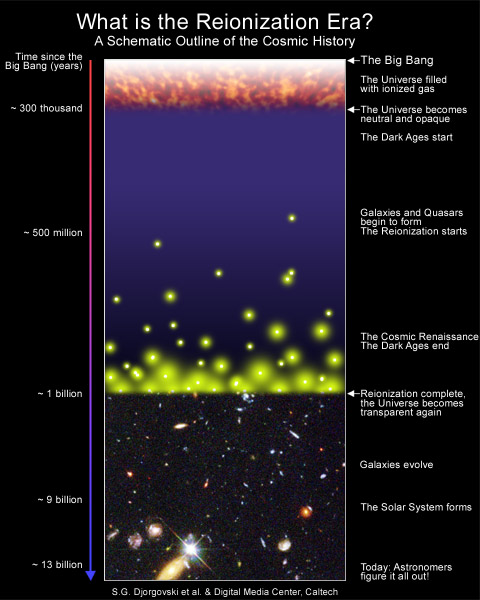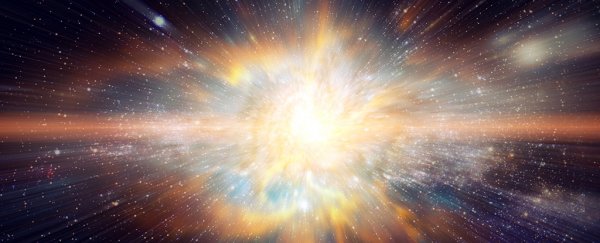A team of scientists working with the Murchison Widefield Array (WMA) radio telescope are trying to find the signal from the Universe's first stars. Those first stars formed after the Universe's Dark Ages.
To find their first light, the researchers are looking for the signal from neutral hydrogen, the gas that dominated the Universe after the Dark Ages.
It took a while for the first stars to form. After the Big Bang, the universe was extremely hot; too hot for atoms to form. Without atoms, there could be no stars.
It wasn't until about 377,000 years after the Big Bang that the Universe had expanded and cooled enough for atoms to form, mostly neutral hydrogen with a little helium. (And traces of lithium.) After that, the earliest stars started to form, during the Epoch of Reionization.
To find the elusive signal from that neutral hydrogen, the MWA was reconfigured. The MWA is in remote Western Australia, and it had 2048 radio antennas arranged into 128 "tiles" when it began operation in 2013.
To hunt for the elusive neutral hydrogen signal, the number of tiles was doubled to 256, and the entire array was rearranged. All the data from these receivers is fed into a supercomputer called the Correlator.
A new paper to be published in the Astrophysical Journal presents the results from the first analysis of data from the newly configured array. The paper is titled "First Season MWA Phase II EoR Power Spectrum Results at Redshift 7." The lead researcher is Wenyang Li, a PhD student at Brown University.
This research was aimed at understanding the strength of the signal from the neutral hydrogen. The analysis set the lowest limit yet for that signal, a key result in the search for the faint signal itself.
"We can say with confidence that if the neutral hydrogen signal was any stronger than the limit we set in the paper, then the telescope would have detected it," said Jonathan Pober, an assistant professor of physics at Brown University and corresponding author on the new paper.
"These findings can help us to further constrain the timing of when the cosmic dark ages ended and the first stars emerged."
Despite what looks like a detailed timeline of events in the early Universe, there are significant gaps in our understanding. We know that following the Dark Ages, the Epoch of Reionization began. That's when the formation of atoms led to the appearance of the first structures in the Universe, like stars, dwarf galaxies, and quasars.
As those objects formed, their light spread through the Universe, re-ionizing the neutral hydrogen. After that, the neutral hydrogen disappeared from interstellar space.
 History of the Universe (Djorgovski et al., Caltech)
History of the Universe (Djorgovski et al., Caltech)
Scientists want to know how the neutral hydrogen changed as the Dark Ages gave way to the Epoch of Reionization, and the Epoch of Reionization unfolded. The first stars to form in the Universe were building blocks of the structure we see today, and to understand them, scientists need to find the signal from that early neutral hydrogen.
But that's not easy. The signal is faint, and it takes extremely sensitive detectors to find it. Though the neutral hydrogen initially emitted its radiation at a 21 cm wavelength, the signal has been stretched due to the expansion of the Universe.
It's now about two meters. That two meter signal is now easily lost among a host of other signals like it, both natural and human-caused. That's why the MWA is in remote Australia, to isolate it from as much radio noise as possible.
"All of these other sources are many orders of magnitude stronger than the signal we're trying to detect," Pober said.
"Even an FM radio signal that's reflected off an airplane that happens to be passing above the telescope is enough to contaminate the data."
This is where the processing power of the Correlator supercomputer comes in. It has the power to discard contaminating signals, and also to account for the nature of the MWA itself.
"If we look at different radio frequencies or wavelengths, the telescope behaves a little differently," Pober said.
"Correcting for the telescope response is absolutely critical for then doing the separation of astrophysical contaminants and the signal of interest."
The reconfiguration of the array, the data analysis techniques, the power of the supercomputer, and the hard work of researchers produced results. The paper presents a new upper limit for the signal from the neutral hydrogen.
This is the second time that scientists working with the MWA have released a new, more finely-tuned limit. With continued progress, scientists hope to find the elusive signal itself.
"This analysis demonstrates that the phase two upgrade had a lot of its desired effects and that the new analysis techniques will improve future analyses," Pober said.
"The fact that MWA has now published back-to-back the two best limits on the signal gives momentum to the idea that this experiment and its approach has a lot of promise."
This article was originally published by Universe Today. Read the original article.
